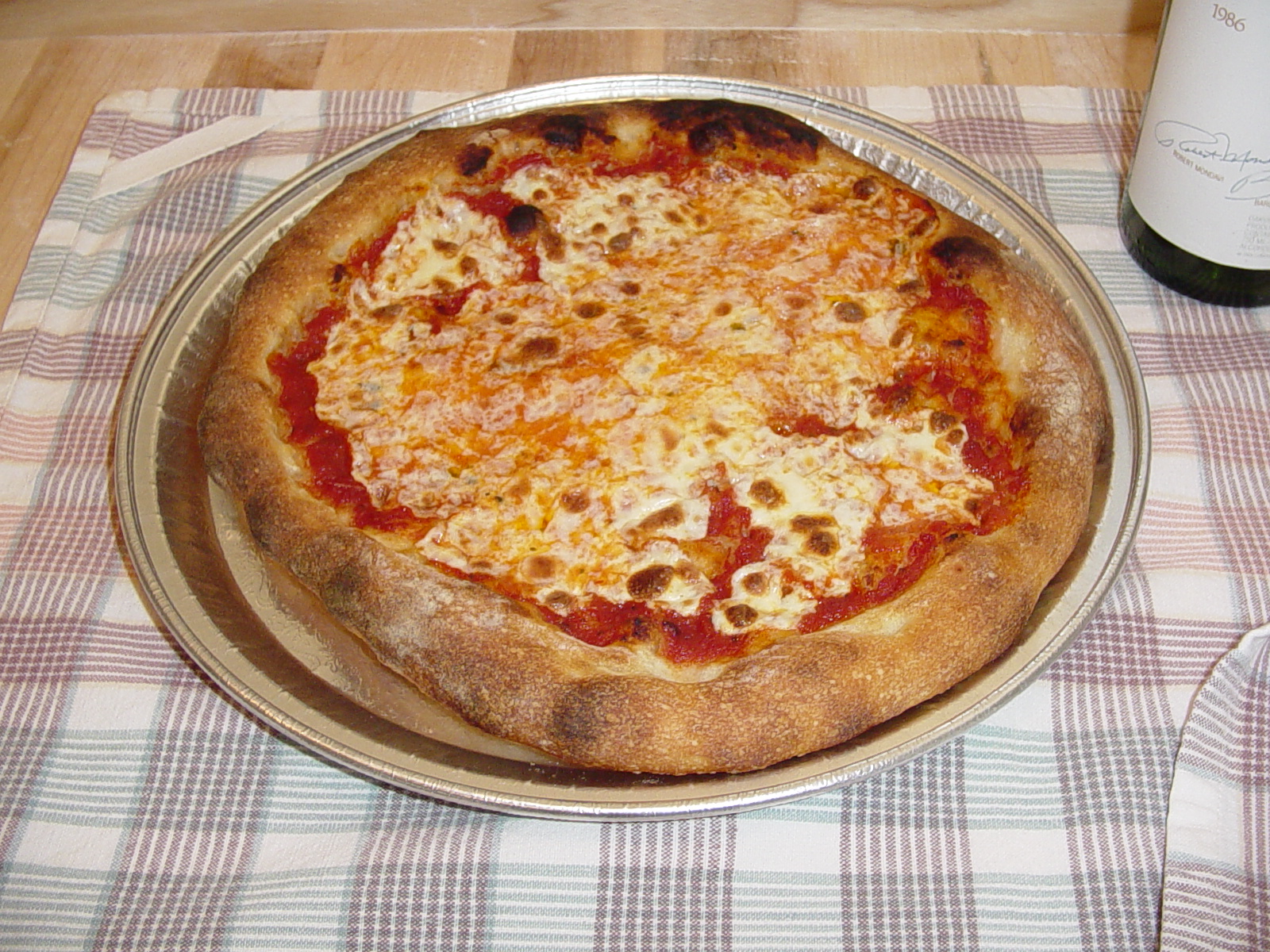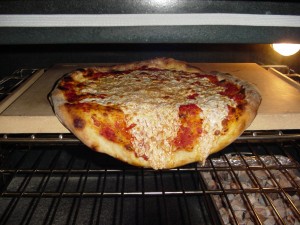New York-Style Pizza
Jul 26th, 2008 by SteveB
Whether it be the crisp, light crust of an authentic Neapolitan, the thick, focaccia-like crust of a Sicilian or the crunchy, chewy crust of a New York-style, pizza is one of the few foods that is almost universally loved. As a “breadie”, I judge the quality of a pizza by its crust; the texture of the crust should be appropriate to the style of pizza being made and the flavor of the crust should be able to stand on its own, even without the, dare I say, “distractions” of the toppings. If the remnants of a pizza repast are littered with uneaten crust, then great pizza was not served.
The formula detailed here uses a sourdough preferment to give a flavor profile to the crust that is just right to my taste. I encourage you to play around with the formula to adjust the flavor to your liking. An extremly useful tool to help in your experimentation is a Preferment Pizza Dough Calculator, which can be found on the Pizza Making forum.
To get the desired chewy texture, King Arthur Sir Lancelot high gluten flour is used. Because of the high gluten level, this is one of the few times where I find a stand mixer to be necessary to fully develop the dough.
Final Dough (makes two, 14″ pizzas)
- 455 g King Arthur Sir Lancelot flour
- 290 g Water
- 10 g Salt
- 1/2 tsp. Instant Dried Yeast
- 105 g Sourdough Starter (50% hydration)
- 10 g Olive Oil
Pizza Sauce (from Artisan Baking Across America)
- 28 oz. can Italian Crushed Tomatoes
- 1 tsp. Dried Oregano
- 1 clove Minced Garlic
- 2 tbs. Extra Virgin Olive Oil
- Salt to taste
Pizza Cheese
- Mozzarella (fresh or low-moisture), cut into 1/2 in. dice. If available, mozzarella di bufala (made from water buffalo milk) is highly recommended.
The night before making the pizzas, place all the ingredients of the final dough in the bowl of a stand mixer and mix on low (speed 2 on a KitchenAid mixer using the spiral dough hook) until the dough is fully developed, about 17-20 minutes. Divide the dough into two equal pieces by weight and shape each piece into a small, tight boule. Place each boule into a lightly oiled, round container, cover and refrigerate overnight.
The next day, take the dough out of the refrigerator and let warm to room temperature for one hour.
To prevent the crust from drying out during baking, it is best to bake the pizza quickly at as high a temperature as possible. For this reason, while the dough is warming, I configure my gas oven specifically for pizza making. To do this, I place my oven rack at its uppermost level, bringing my baking stone to within inches of my oven’s broiler. This way, after the oven has pre-heated to its highest temperature (a bit over 500°F), I can turn on the broiler to heat my baking stone to an even higher temperature. The broiler is then turned off right before baking. This gives the pizza a nice crisp crust. Or course, it also makes the pizza that much harder to load into the oven. For this pupose, I use a SuperPeel. The SuperPeel is the closest I’ve seen to a home version of a baker’s oven loader and works quite well when loading the pizza into such a confined space.
After the dough has sat at room temperature for one hour and the oven has been set-up and preheated, the dough is removed from its container, shaped into a 14″ disk, topped and baked until golden brown (about 6-7 minutes), as shown:
[qt:http://www.breadcetera.com/wp-content/uploads/2008/07/PizzaMaking.mov 500 375]
Postscript – For those of you who plan on trying the method described above for heating your baking stone, I suggest extra care in loading the pizza into the oven. With a standard peel, it proved to be difficult. The result, what I call “The Persistence of Pizza” in homage to the great surrealist painter Salvador Dali, can be seen below:


i place my stone in the oven and put oven on broil for atleast 1 hour to get it nice and hot then i turn down and continue heating on 500 then place pizza on stone cooks fast and crust comes out just like back home in ny style ps i purchases a special 1 inch thick stone that can handle direct fire on a outdoor grill or in the hottest ovens otherwise if you purchase them cheap stones they will crack on you so save yourself the extra cash and buy a good stone learn from my mistakes ive cracked many of the $50.00 and less stones just cant handle the heat needed to bake a great pizza
Just discovered Breadcetera by accident. I follow no blogs, but I will certainly make an exception for this exceptional one!
Keith K.